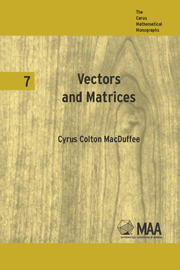Book contents
INTRODUCTION
Summary
The theory of matrices had its origin in the theory of determinants, and the latter had its origin in the theory of systems of equations. From Vandermonde and Laplace to Cayley, determinants were cultivated in a purely formal manner. The early algebraists never successfully explained what a determinant was, and indeed they were not interested in exact definitions.
It was Cayley who seems first to have noticed that “the idea of matrix precedes that of determinant.” More explicitly, we can say that the relation of determinant to matrix is that of the absolute value of a complex number to the complex number itself, and it is no more possible to define determinant without the previous concept of matrix or its equivalent than it is to have the feline grin without the Cheshire cat.
In fact, the importance of the concept of determinant has been, and currently is, vastly over-estimated. Systems of equations can be solved as easily and neatly without determinants as with, as is illustrated in Chapter I of this Monograph. In fact, perhaps ninety per cent of matric theory can be developed without mentioning a determinant. The concept is necessary in some places, however, and is very useful in many others, so one should not push this point too far.
In the middle of the last-century matrices were approached from several different points of view. The paper of Hamilton (1853) on “Linear and vector functions” is considered by Wedderburn to contain the beginnings of the theory.
- Type
- Chapter
- Information
- Vectors and Matrices , pp. v - viiiPublisher: Mathematical Association of AmericaPrint publication year: 1943

